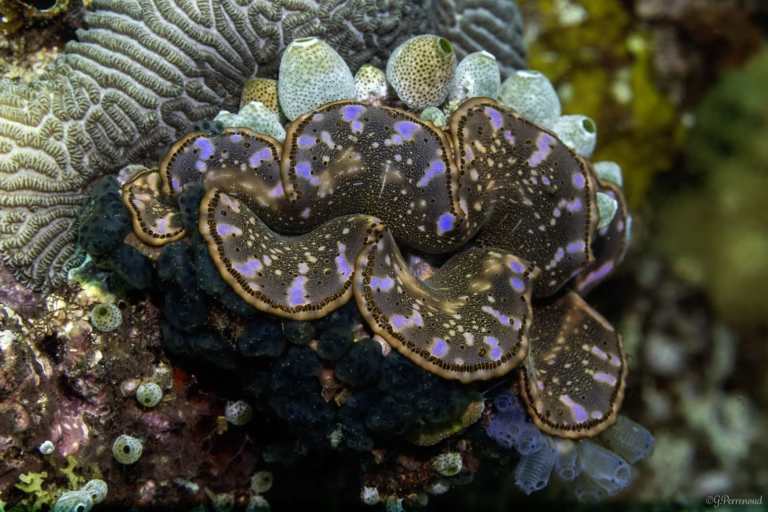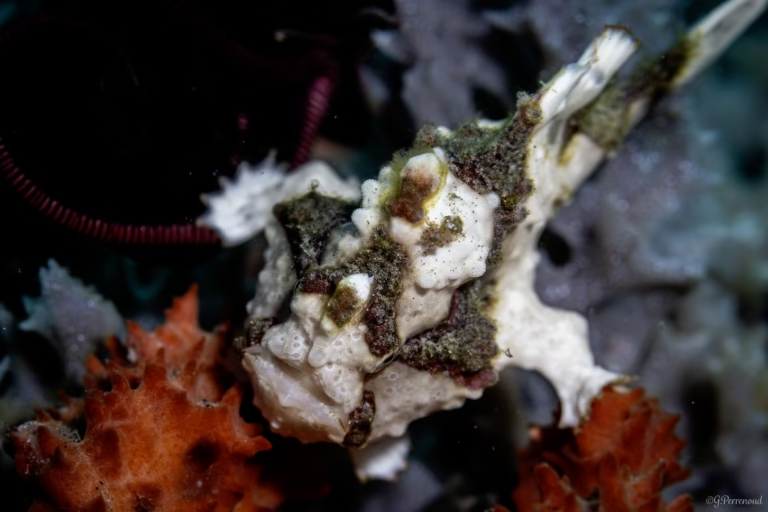

Table of contents
Introduction
Giant clams are true ocean titans. The largest ones weigh an astounding 330 kg and stretch more than 1.2m across. These remarkable creatures make their home in the Indo-Pacific waters and Great Barrier Reef, where they demonstrate nature’s incredible engineering.
The marine giants grow to such impressive sizes through an amazing partnership. Billions of tiny algae live within their tissues and provide up to 70% of the clam’s food through photosynthesis. This relationship helps them flourish even in waters with few nutrients. These magnificent creatures can live for nearly a century, but their survival hangs in the balance. Their numbers are declining faster than ever due to overharvesting, which has led to their classification as Critically Endangered.
Let’s explore these ocean marvels together and learn about their extraordinary world. We’ll look at their unique features, survival strategies, and the critical work needed to protect them.

The World's Largest Living Shells
The Indo-Pacific region’s coral reefs are home to magnificent mollusks that showcase nature’s architectural brilliance. Tridacna gigas, known as the true giant clam, stands as Earth’s largest living bivalve [1]. These marine giants build massive calcified shells that protect them and benefit the ecosystem [2].
The ocean giants’ shells have unique features. T. gigas develops thick, heavy shells with deep radial folds. Its mantle shows yellowish-brown to olive-green colors [4]. The mantle’s lateral edges display many small, brilliant blue-green rings that catch the eye [4].
The giant clam family includes various species with distinct sizes:
- T. squamosa grows up to 40 cm [5]
- T. derasa, the southern giant clam, reaches 50 cm [6]
- T. maxima remains the most common species throughout the tropical Indo-Pacific [5]
- T. crocea, the family’s smallest member, extends to 15 cm [5]
- The Bear Claw Clam (Hippopus) stretches to about 45 cm
Two aragonitic layers make up these remarkable shells – inner and outer [7]. The shells create vital habitats for many encrusting organisms and help form reefs through carbonate deposition [2]. They snap shut quickly when they detect movement nearby, which helps protect them from predators [8].
The shell’s elemental composition determines its strength and durability. Research continues on how environmental changes affect shell composition, especially with ocean warming and acidification. This vital research helps scientists understand how these amazing creatures might adapt to changing oceans and guides efforts to protect their dwindling populations [2].

Nature's Living Solar Panels
Giant clams hide an extraordinary solar energy system that works better than modern technology inside their vibrant shells. These marine marvels have specialized cells called iridocytes that create a thin, light-scattering layer on their surface and direct sunlight with amazing precision [9].
Their unique internal architecture makes them incredibly efficient. These clams arrange photosynthetic algae in vertical columns beneath the iridocyte layer that align parallel to incoming light for the best absorption. The iridocytes then scatter and filter this light to create a uniform wrap around each algal cylinder.
This natural solar system’s efficiency is remarkable. Scientists found that these clams absorb approximately 95% of incoming sunlight. Their quantum efficiency – knowing how to convert photons into electrons – reaches 42%. The clams have another clever adaptation. They stretch their tissues when sunlight conditions change and boost their quantum efficiency up to 67% [9].
Let’s see what these numbers mean. Green leaves in tropical environments only achieve 14% efficiency, and today’s solar panels convert just 20% of sunlight into electrical power [11]. Giant clams owned a system that works at more than triple the efficiency!
The iridocytes play multiple roles in this sophisticated system. They direct photosynthetically productive wavelengths deeper into the tissue through lateral and forward-scattering. A specialized structure called a Bragg mirror reflects non-productive wavelengths [12].
Nature’s ingenuity shines through this intricate partnership between clam and algae. The clam gives its algal partners nitrogen and other nutrients. The algae use their improved photosynthetic capabilities to produce organic molecules that feed the clam [11]. This arrangement works so well that these photosynthetic products meet most of the clams’ carbon and energy needs [13].
This remarkable system could inspire next-generation solar technologies. Scientists think about applications from more efficient algae-based biofuel production to innovative solar panels with stretchy materials that mimic the clams’ ability to adapt to changing light conditions.

Life Cycle of Ocean Giants
Giant clams have an extraordinary way of reproducing that makes their life experience truly remarkable. These marine marvels begin their lives as males and later develop both male and female reproductive abilities. A mature adult releases an incredible 500 million eggs during a single spawning event.
These ocean giants develop faster in their early life stages. Their eggs float freely in the ocean for about 12 hours until they hatch into trochophore larvae. The newly hatched larvae are tiny – just 160 micrometers, about the thickness of a human hair [15]. The larvae must feed on plankton at this point since they haven’t formed their significant symbiotic bond with zooxanthellae yet.
The larvae go through several changes as they grow. They evolve into filter-feeding veliger larvae by day two and develop their first calcium carbonate shells. The larvae transform into pediveligers after about a week and get the ability to crawl along the ocean floor with a specialized foot.
Growing into adults comes with many challenges. The natural mortality rates are extremely high – all but one percent of larvae make it to juvenile status [16]. The survivors build their life-defining partnership with zooxanthellae through an interesting process. They catch free-floating zooxanthellae while filter feeding [15]. These algal cells resist digestion and eventually settle in the clam’s developing mantle [17].
The juveniles reach a most important milestone at about 20 centimeters in length. Laboratory-raised specimens can grow 12 centimeters each year under the right conditions. Their body structure changes completely during development, which lets their fleshy mantles extend beyond their shells – something unique among bivalves [15].
Giant clams tell an even more fascinating story with their longevity. These marine creatures can live beyond 100 years [1], though environmental stressors threaten their survival today. To name just one example, like coral, see how they might expel their vital zooxanthellae partners if the water gets too warm, which puts them at risk of starvation [1].

Conclusion
Giant clams are evidence of nature’s engineering genius. Their solar energy system works better than our modern technology. The clams can absorb 95% of light, which shows how nature’s breakthroughs could help us.
The life story of these sea creatures is the sort of thing I love. They begin as tiny larvae and develop into massive filter-feeders that can live beyond 100 years! It’s mind-blowing! These creatures have incredible ways to survive, but their existence faces serious threats from overharvesting and environmental challenges.
Scientists keep studying these magnificent beings, especially when you have their unique shell structure and ability to use photosynthesis. Their research helps us learn about how these creatures might handle changing ocean conditions. We’re discovering more about these hidden Pacific treasures every day. We must act quickly to save them because losing these remarkable creatures means we lose both a species and nature’s engineering lessons that could help future generations.

FAQ
- How large can giant clams grow? Giant clams can reach impressive sizes, with the largest species, Tridacna gigas, growing up to 4 feet across and weighing up to 750 pounds. The largest recorded specimen was found off Ishigaki Island, Japan, measuring 3 feet 9 inches in length.
- What makes giant clams unique in terms of energy production? Giant clams have developed a remarkable natural solar energy system. They possess specialized cells called iridocytes that scatter and filter light with incredible efficiency, allowing them to absorb about 95% of incoming sunlight. This system outperforms modern solar panels and even surpasses the efficiency of the Amazon rainforest.
- How do giant clams reproduce? Giant clams are protandrous hermaphrodites, starting life as males before developing both male and female reproductive capabilities. A single adult can release up to 500 million eggs in one spawning event. The fertilized eggs then go through several larval stages before settling as juveniles.
- How long can giant clams live? These marine giants can potentially live for over a century. However, their longevity is increasingly threatened by environmental stressors such as overharvesting and changes in water temperature.
- Are giant clams dangerous to humans? Contrary to popular myths, giant clams are not dangerous to humans. There have been no reported deaths from giant clams, and stories of divers being trapped by them are unfounded. These creatures are actually quite harmless despite their impressive size.
References
[1] – https://www.anspblog.org/through-the-sands-of-time-giant-clams-as-paleoclimate-timekeepers/
[2] – https://www.nature.com/articles/s41598-022-14503-4
[3] – https://guinnessworldrecords.com/world-records/70401-largest-clam
[4] – https://www.fisheries.noaa.gov/species/true-giant-clam
[5] – https://www.qualitymarine.com/news/giant-clams-identification-101/
[6] – https://pmc.ncbi.nlm.nih.gov/articles/PMC5627105/
[7] – https://www.sciencedirect.com/science/article/pii/S2352340923009782
[8] – https://www.cell.com/current-biology/pdf/S0960-9822(13)01517-0.pdf
[9] – https://news.yale.edu/2024/06/28/giant-clams-may-hold-answers-making-solar-energy-more-efficient
[10] – https://www.scientificamerican.com/article/most-efficient-solar-panels-ever-have-been-found-in
[11] – https://www.aveva.com/en/perspectives/blog/how-to-increase-solar-energy-efficiency-with-giant-clams/
[12] – https://pmc.ncbi.nlm.nih.gov/articles/PMC4223897/
[13] – https://microbiomejournal.biomedcentral.com/articles/10.1186/s40168-020-00835-8
[14] – https://www.barrierreef.org/the-reef/animals/giant-clam
[15] – https://en.wikipedia.org/wiki/Giant_clam
[16] – https://www.researchgate.net/publication/260020319_Giant_Clam_Aquaculture_a_Review_on_Induced_Spawning
[17] – https://www.researchgate.net/figure/Life-cycle-and-timeline-of-giant-clam-larval-development-according-to-Mies-and-Sumida_fig1_304000681



